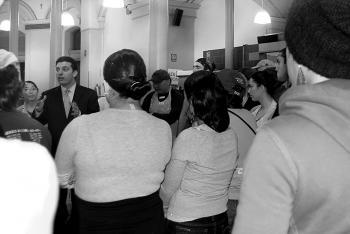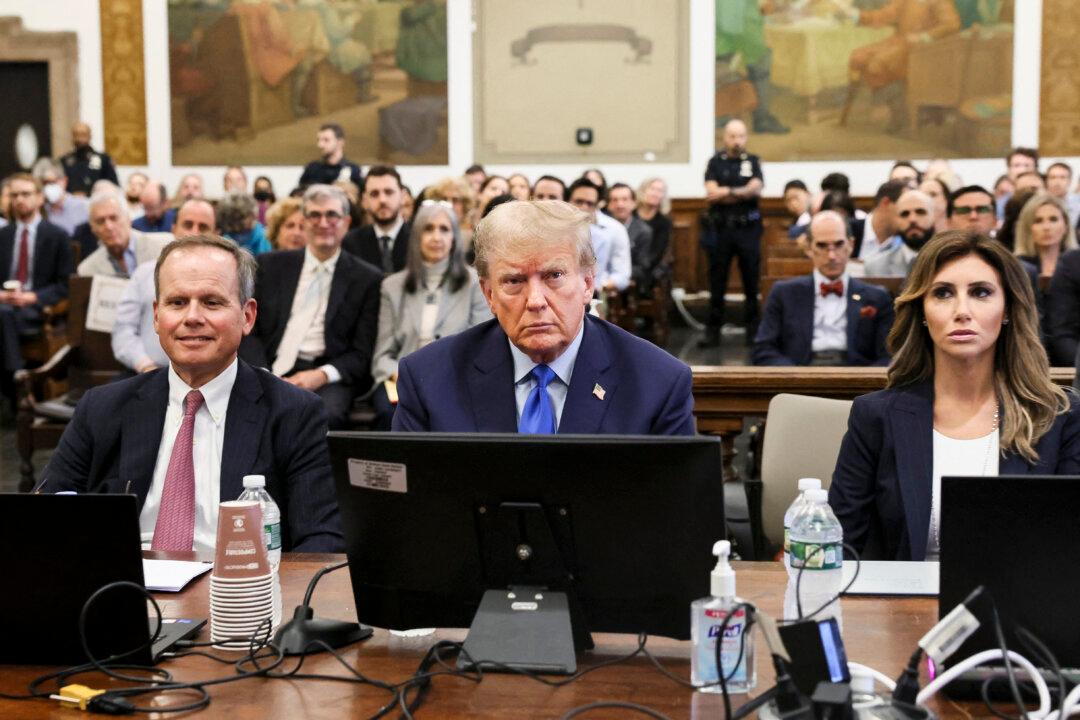Councilman Eric Gioia was joined by MeMe Roth, president of National Action Against Obesity (NAAO), Sunday, April 19, in his proposal to ban fast food restaurants within 0.1 miles, or about 500 feet, of schools.
A study released by the University of California and Columbia University, “The Effect of Fast Food Restaurants On Obesity,” found a clear link between obesity in students and the distance of fast food from schools. Councilman Gioia’s investigation found neighborhoods with the highest obesity rates in New York City have 28 fast food restaurants within 500 feet of their schools. About 50 percent of elementary schoolchildren in New York are at an unhealthy weight, 20 percent of kindergartners in New York are obese, and 40 percent of children in Harlem are obese.
Janet Currie, co-author of the study, and Sami Mnaymeneh, professor of Economics and chair of the Department of Economics at Columbia University, say that the link between obesity and fast food outlets within 0.1 miles does not seem to be due to other characteristics of the children or neighborhoods, and legislation restricting fast food access would help the epidemic of childhood obesity.
Gioia said that children this age are literally being poisoned by their food environments.
“This study has confirmed what many of us have known for years: that proximity to fast food leads to an unhealthy lifestyle,” he said. “Banning fast food around schools will have a measurable impact on students’ lives, and will help them grow up to be healthier, stronger adults.”
He added that educators in schools mentioned students skipping lunch, because they knew they could get cheap, fast food across the street after school. The health consequences do not end at weight problems. Obesity leads to heart disease, diabetes, cancer, hypertension, liver and gallbladder disease, sleep apnea, and respiratory problems. According to the Lancet Medical Journal, those who eat fast food with regularity are more than twice as likely to develop diabetes, and a study in 2003 showed regular fast food consumption in school-age children added an average of six pounds a year.
Roth said that, both as a parent of two children going to public schools in NYC and president of NAAO, she supports this legislation.
“NAAO believes predatory marketing of junk food escalates the child obesity health crisis,” she said. “Research reveals that fast food restaurants’ close proximity to schools increases child obesity.”
Other national, state, and city organizations have expressed support for this proposal as well.
“Obesity is a significant and growing problem among New York’s children, including those that are low-income,” said Mark Dunlea, executive director of the Hunger Action Network of New York State. “Increased government action restricting children’s access to unhealthy foods is long overdue. In addition, we hope that state lawmakers finally pass the Healthy Schools Act to end the sale of junk food in our schools.”
Amie Hamlin, executive director of New York Coalition for Healthy School Food, says locating a fast food restaurant next to a school is a predatory practice.
“In our society, healthy food is not the convenient choice, not the least expensive choice, and this needs to change,” she said. “We have found students actually enjoy good tasting healthy food.”
A study released by the University of California and Columbia University, “The Effect of Fast Food Restaurants On Obesity,” found a clear link between obesity in students and the distance of fast food from schools. Councilman Gioia’s investigation found neighborhoods with the highest obesity rates in New York City have 28 fast food restaurants within 500 feet of their schools. About 50 percent of elementary schoolchildren in New York are at an unhealthy weight, 20 percent of kindergartners in New York are obese, and 40 percent of children in Harlem are obese.
Janet Currie, co-author of the study, and Sami Mnaymeneh, professor of Economics and chair of the Department of Economics at Columbia University, say that the link between obesity and fast food outlets within 0.1 miles does not seem to be due to other characteristics of the children or neighborhoods, and legislation restricting fast food access would help the epidemic of childhood obesity.
Gioia said that children this age are literally being poisoned by their food environments.
“This study has confirmed what many of us have known for years: that proximity to fast food leads to an unhealthy lifestyle,” he said. “Banning fast food around schools will have a measurable impact on students’ lives, and will help them grow up to be healthier, stronger adults.”
He added that educators in schools mentioned students skipping lunch, because they knew they could get cheap, fast food across the street after school. The health consequences do not end at weight problems. Obesity leads to heart disease, diabetes, cancer, hypertension, liver and gallbladder disease, sleep apnea, and respiratory problems. According to the Lancet Medical Journal, those who eat fast food with regularity are more than twice as likely to develop diabetes, and a study in 2003 showed regular fast food consumption in school-age children added an average of six pounds a year.
Roth said that, both as a parent of two children going to public schools in NYC and president of NAAO, she supports this legislation.
“NAAO believes predatory marketing of junk food escalates the child obesity health crisis,” she said. “Research reveals that fast food restaurants’ close proximity to schools increases child obesity.”
Other national, state, and city organizations have expressed support for this proposal as well.
“Obesity is a significant and growing problem among New York’s children, including those that are low-income,” said Mark Dunlea, executive director of the Hunger Action Network of New York State. “Increased government action restricting children’s access to unhealthy foods is long overdue. In addition, we hope that state lawmakers finally pass the Healthy Schools Act to end the sale of junk food in our schools.”
Amie Hamlin, executive director of New York Coalition for Healthy School Food, says locating a fast food restaurant next to a school is a predatory practice.
“In our society, healthy food is not the convenient choice, not the least expensive choice, and this needs to change,” she said. “We have found students actually enjoy good tasting healthy food.”






Friends Read Free